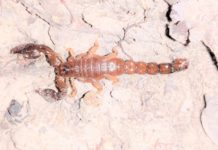PROFILE
SCIENTIFIC NAME Leptodactylus fallax
KNOWN AS mountain chicken
LOCATION Montserrat and Dominica, Eastern Caribbean
CONSERVATION STATUS Critically Endangered
BIOLOGY & TAXONOMY
The Mountain Chicken is the largest of all living Leptodactylus species, and is one of the largest of all living frog species. It can reach a head and body length of over 20 cm, weigh over 900 g and live for up to 12 years. They have powerful hind legs, hence, their popularity as a traditional Caribbean dish and their common name of ‘mountain chicken.’ The frogs have striking patterns of dark bars and blotches which effectively camouflages them against the forest floor when they’re not hiding in burrows or rock crevices. Males are extremely territorial and have wrestling contests to seize and defend territories.
Mountain chickens are the top endemic predator on Montserrat and are one of only two native frog species. They are most active after dusk when they hunt for insects, land snails, spiders, and even snakes. This is the time they also search for mates in the breeding season.
Mountain chickens have an unusual breeding system with a high degree of maternal care. Females will produce a foam nest at the bottom of a male’s burrow into which her eggs are laid. The tadpoles develop within the foam nest as the male and female guard and defend the nest against intruders.
A mother will feed her tadpoles her own unfertilised eggs to enable them to grow (tadpoles reach an incredible 150 mm in length). Once individuals metamorphose and leave the parental nest, they receive no more care from either parent. In captivity, females have only been seen to produce one fertile nest of around 25-63 froglets per year, which is quite a low reproductive rate.
The mountain chicken reaches maturity at around 3 years, and has a lifespan of approximately 12 years. Mature females only produce one brood per season, but male frogs may have offspring with more than one female.






